How Play-Calling Tendencies Affect Fantasy Football (2024)

Half of the league will start with a different offensive play caller in 2024 than they started with in 2023. Now, I am fudging that up a bit by including Joe Brady who took over mid-season for the Bills, and Nathaniel Hackett who will be the play caller in name only for the Jets. With all of that change in mind, what I’ll do here is introduce some key topics like pass rate over expected (PROE), pace, and motion rate. These topics are key to understanding what these play callers want to do. And then I’ll go team by team discussing what we’re likely to see with some of the league’s changing play callers.
| Team | 2023 Playcaller | 2024 Playcaller | New to Team? |
|---|---|---|---|
| Arizona Cardinals | Drew Petzing | Drew Petzing | |
| Atlanta Falcons | Arthur Smith | Zac Robinson | Yes |
| Baltimore Ravens | Todd Monken | Todd Monken | |
| Buffalo Bills | Ken Dorsey / Joe Brady | Joe Brady | |
| Carolina Panthers | Frank Reich / Thomas Brown | Dave Canales | Yes |
| Chicago Bears | Luke Getsy | Shane Waldron | Yes |
| Cincinnati Bengals | Zac Taylor | Dan Pitcher | Yes |
| Cleveland Browns | Kevin Stefanski | Kevin Stefanski | |
| Dallas Cowboys | Mike McCarthy | Mike McCarthy | |
| Denver Broncos | Sean Payton | Sean Payton | |
| Detroit Lions | Ben Johnson | Ben Johnson | |
| Green Bay Packers | Matt LaFleur | Matt LaFleur | |
| Houston Texans | Bobby Slowik | Bobby Slowik | |
| Indianapolis Colts | Shane Steichen | Shane Steichen | |
| Jacksonville Jaguars | Press Taylor | Press Taylor | |
| Kansas City Chiefs | Andy Reid | Andy Reid | |
| Los Angeles Rams | Sean McVay | Sean McVay | |
| Los Angeles Chargers | Kellen Moore | Greg Roman | Yes |
| Las Vegas Raiders | Josh McDaniels / Bo Hardegree | Luke Getsy | Yes |
| Miami Dolphins | Mike McDaniel | Mike McDaniel | |
| Minnesota Vikings | Kevin O'Connell | Kevin O'Connell | |
| New England Patriots | Bill O'Brien | Alex Van Pelt | Yes |
| New Orleans Saints | Pete Carmichael | Klint Kubiak | Yes |
| New York Giants | Mike Kafka | Mike Kafka | |
| New York Jets | Nathaniel Hackett | Nathaniel Hackett | |
| Philadelphia Eagles | Brian Johnson | Kellen Moore | Yes |
| Pittsburgh Steelers | Matt Canada / Mike Sullivan | Arthur Smith | Yes |
| Seattle Seahawks | Shane Waldron | Ryan Grubb | Yes |
| San Francisco 49ers | Kyle Shanahan | Kyle Shanahan | |
| Tampa Bay Buccaneers | Dave Canales | Liam Coen | Yes |
| Tennessee Titans | Tim Kelly | Brian Callahan | Yes |
| Washington Commanders | Eric Bieniemy | Kliff Kingsbury | Yes |
PROE, Pace, and Motion Rates
This is going to be a graph-heavy section but stick with me. Before looking at PROE, let’s check why we care about pass rate in the first place. The graph below shows passing expected points added (EPA) on the x-axis and rushing EPA on the y-axis. EPA measures how much each play impacts a team’s potential to score. If the team’s likelihood to score increases after a play, then EPA increases, and the opposite is true if the team’s scoring potential decreases.
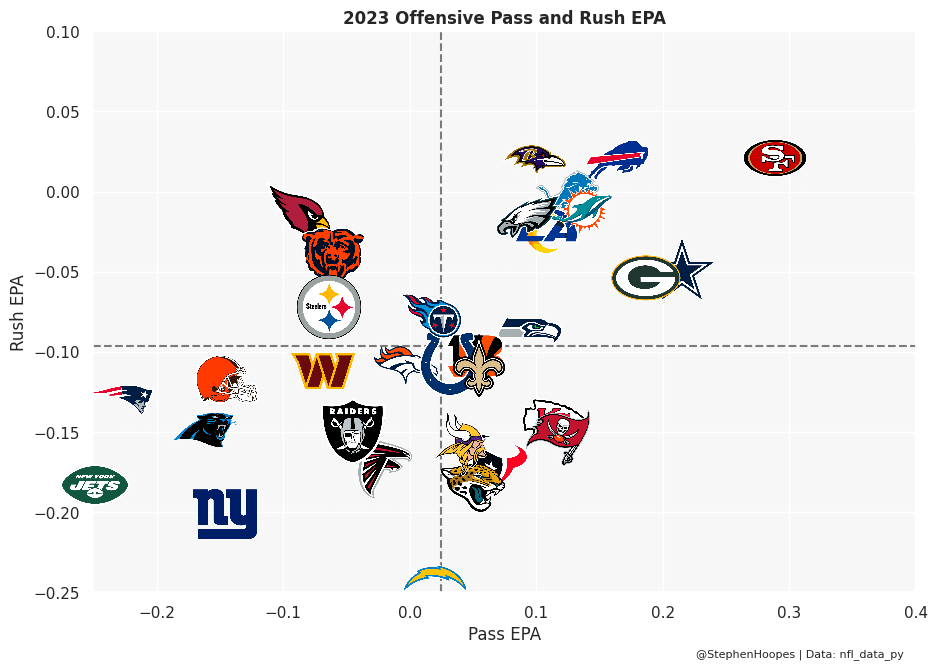
What you’ll notice by looking at the dashed lines that indicate the league average is that passing is much more efficient than rushing. The average team’s passing EPA is just north of zero, while the average team’s rushing EPA is about -0.10 per play. And so generally, the most efficient offenses that we want to target in fantasy football are prioritizing pass rate.
With that in mind, the graph below shows a team’s PROE on the x-axis and how much that fluctuated weekly on the y-axis. PROE starts by calculating how often a typical team would pass or run in a given situation (i.e. down, distance, score differential, etc.). And then it compares what a team actually did in that situation. Teams that passed more than expected have a PROE above zero, and the opposite is true for teams that passed less than expected. What you’ll notice is that most of the efficient teams we saw in the previous graph have high PROEs.

In addition to efficiency, we also need volume for fantasy football. And teams that play quickly tend to produce more plays and more fantasy point-scoring potential for our teams. The graph below shows team pace on the x-axis and their no-huddle rate on the y-axis. The pace metric is the average number of seconds remaining on the play clock at the snap. And we’re only looking at neutral situations or plays in the first three-quarters of the game where the score is within eight points.
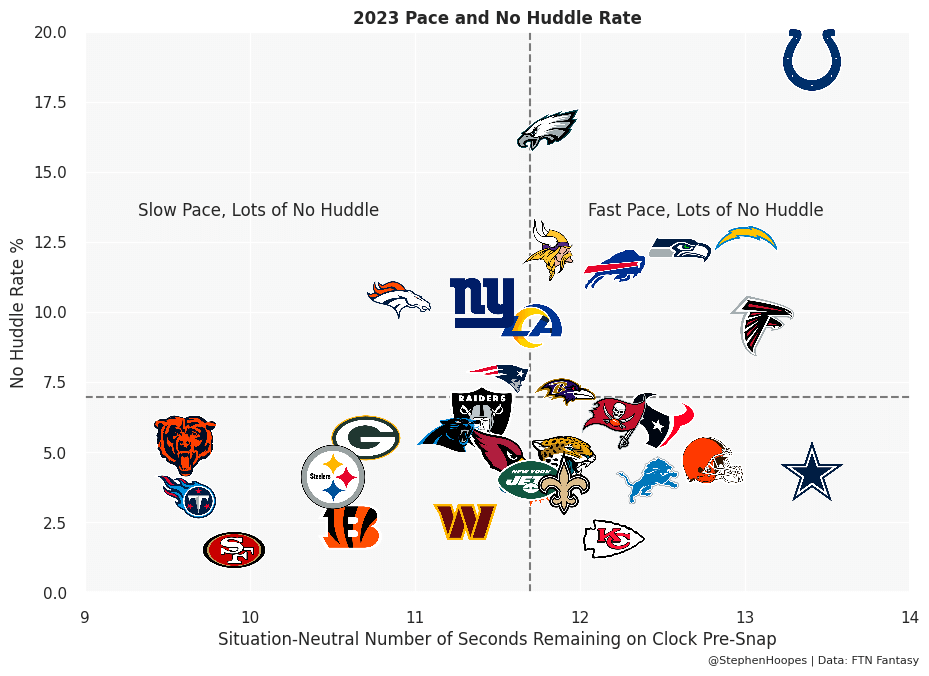
And the final topic before digging into team-level expectations is motion. The Dolphins led the way last year with their out-or-cheat motions that weaponized the speed of Tyreek Hill and Jaylen Waddle pre-snap. And teams throughout the league and even the college ranks took notice and quickly copied these plays. The graph below shows motion rate per drop back on the x-axis and how efficient those plays were on the y-axis.
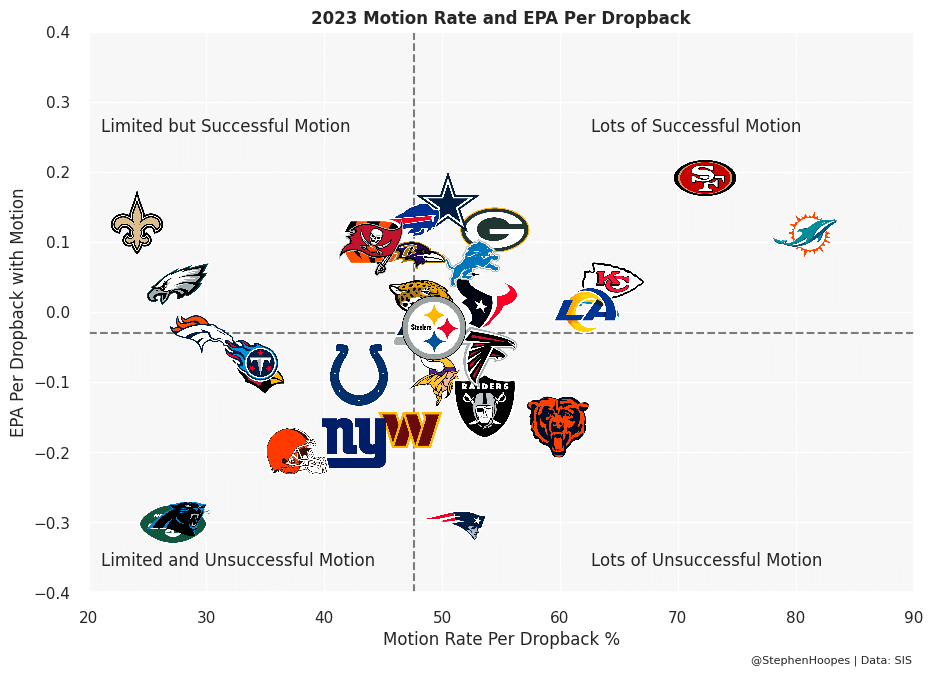
A heavy use of motion is a positive sign for two reasons. The first is it can be an effective way to create an explosive play in the very-low-target-depth age of the new NFL. The second is it shows the willingness of the offensive play caller to adapt and try new things. We want to be investing in offenses that are dynamic and motion rate is one positive indicator.
Team-by-Team Analysis
Atlanta Falcons
Arthur Smith and his revulsion to fantasy football are out of Atlanta. And in steps Zac Robinson off of the Sean McVay coaching tree. The Falcons’ increase in PROE in 2024 would be my bet for the most relevant change in fantasy football. As you saw in the PROE graph above, the Falcons were not only last in PROE in 2023, but they were in a different stratosphere than the rest of the league. Arthur Smith is moving to the Steelers who were 30th in PROE last season. And 32nd vs 30th doesn’t sound like that large of a change until you realize that the difference between the Falcons and Steelers was the same as between the Steelers and the Dolphins. Competent QB play and an actually serious PROE are crucial reasons for hope for Drake London and Kyle Pitts.
The other absolutely massive change we’ll see in Atlanta this year is in the use of 2-TE sets. The graph below shows the number of dropbacks where the team had two TEs on the field on the x-axis and the efficiency of those passes on the y-axis. The Falcons were once again a massive outlier on the graph. Meanwhile, the Rams used the least 2-TE sets in the entire league. My assumption is Zac Robinson will follow McVay’s suit and use a heavy dose of 3-WR sets in 2024. And we saw that in their first preseason game, where the Falcons had three WRs on the field in 23 of the 24 plays where Michael Penix played. At the very least, this means Darnell Mooney and Ray-Ray McCloud will be on the field a lot, even if we don’t anticipate a lot of fantasy relevance for them.

Buffalo Bills
I’m including the Bills here because we saw some pretty interesting splits between Ken Dorsey and Joe Brady last season. Under Brady, the Bills were much more run-heavy with a slower pace. That is not ideal for their receiving options if this continues in 2024. And those receiving options have downgraded dramatically with the departure of Stefon Diggs. With that drop in receiving threats, we might see a lot more TE usage. In a very limited sample in pre-season with the starters, the Bills had two TEs on the field for five of their eight snaps.
One positive indicator for the Bills is their success on play action increased in the second half of the season. The graph below shows the share of play action used per drop back on the x-axis and the efficiency of those passes on the y-axis. But even with that efficiency, the Bills’ use of play action declined under Brady. With the increased focus on the Bills’ run game, here’s hoping we see some efficient play-action passing working off of it.
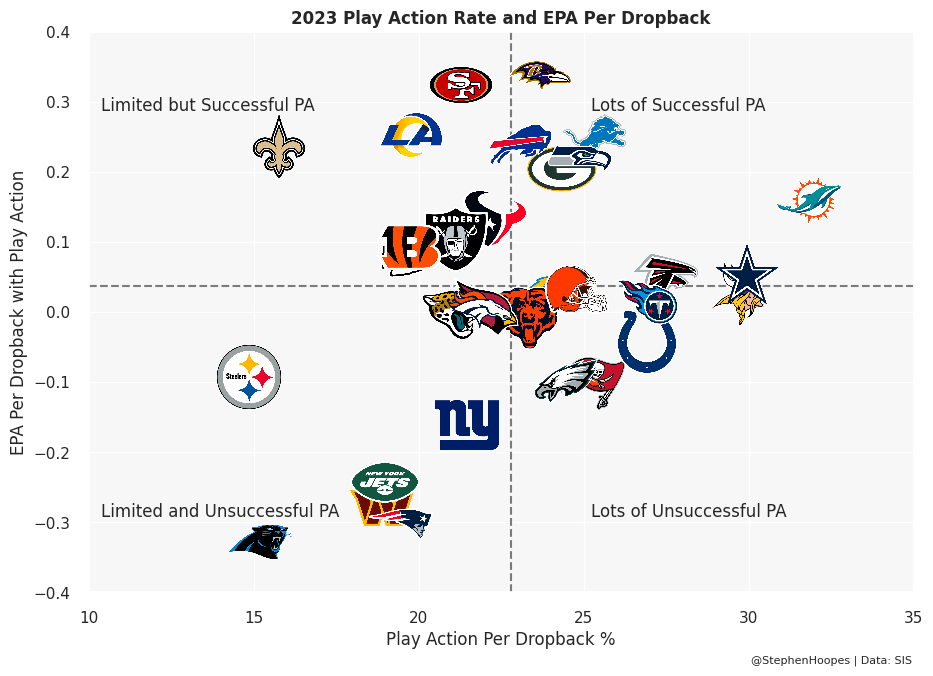
Chicago Bears
The Luke Getsy experience is thankfully over for Bears fans. And while it won’t be as large as for the Falcons, we should see a massive jump in PROE for the Bears. The Bears were bottom-five in PROE last season, while Shane Waldron was top-10 with the Seahawks. We might see an even larger jump in pace, as the Bears operated the slowest offense in football last season while the Seahawks were among the 10 fastest teams.
The biggest question for me is how often will the Bears use 3-WR sets. The Bears’ receiving weapons would suggest they’d be in 3-WR sets almost exclusively. But we didn’t really see that when Waldron was in Seattle to go along with some questionable usage surrounding Jaxon Smith-Njigba and his target depth. And in a very small sample in the preseason, the Bears only used 3-WR sets on 44% of their snaps with the starters. Now, I wouldn’t fade Rome Odunze because of the formation use in one preseason game, but the Bears’ use of 3-WR sets might be lower than you’d expect.
Cleveland Browns
The Browns’ neutral PROE last season doesn’t tell the full story. They were extremely run-heavy prior to the Nick Chubb and Deshaun Watson injuries and then extremely pass-heavy after those injuries. So, what version of the Browns will we get in 2024?
Given that Nick Chubb remains injured and the Browns signed Ken Dorsey, who was extremely pass-heavy with the Bills, a fair assumption would be we’re going to see the high PROE version of the Browns from late last season. The main thing standing in the way of that is Watson’s health. He’s now cleared for full contact but reports on his performance in training camp were mixed at best. A pass-heavy Browns team would be excellent for both Amari Cooper and David Njoku, but the way this goes is entirely dependent on how close Watson returns to his Texans form.
Los Angeles Chargers
The Chargers are my bet for the team with the biggest drop in PROE versus last season. If their time together in San Francisco is any indication, Jim Harbaugh and Greg Roman are going to want to run the ball a lot more than we’d want. I would similarly guess that this team’s pace slows down more than any other NFL team, besides the Jets. I wouldn’t expect much motion here, either. The Chargers are in the pole position to run the most pre-historic offense in the league.
New York Jets
The addition of the Jets here is a bit tongue-in-cheek, as Nathaniel Hackett is technically still the offensive coordinator. But in reality, this is Aaron Rodgers’ offense. And because of that, the Jets’ pace should slow more than any other team in the league this year. If I had to bet on the Jets with a healthy Rodgers or the field for the slowest team, I’d take a hard look at the Jets.
The graph below shows the neutral situation pace for Rodgers over his last seven healthy seasons. The dashed lines show changes in offensive coordinator with the Packers. When looking at who has a larger influence on pace, an existing QB or a new offensive play caller, I found that it’s almost always the QB. And that’s certainly the case with Rodgers-led teams. Rodgers’ pace in each of his last seven healthy seasons was slower than any NFL team last season. There has been some discussion about using less motion and keeping the pace up in Jets camp. But they already barely used motion last season. The Jets are going to move at a snail’s pace this year.
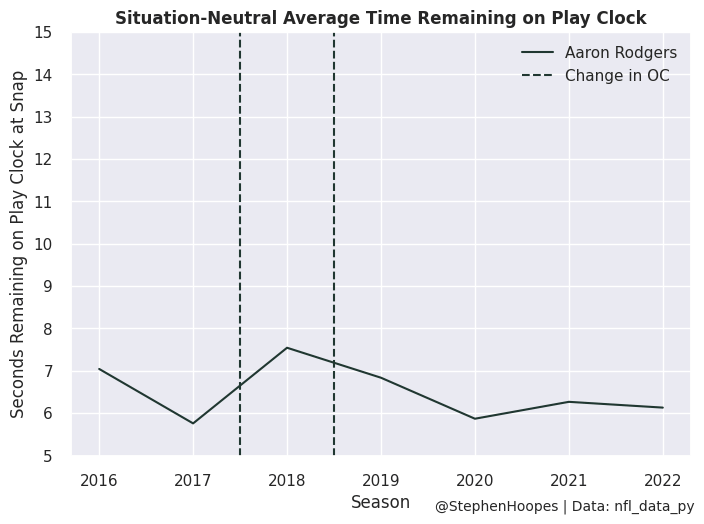
Philadelphia Eagles
I mentioned above that in almost every case, the QB has a larger influence on team pace compared to a new offensive play caller. But there are some exceptions. Kellen Moore, the Eagles’ new play caller, is the most glaring exception.
The graph below shows the average number of seconds remaining on the play clock when the ball was snapped throughout Dak Prescott’s career. And the dashed line shows when Kellen Moore was hired in Dallas. The average number of seconds remaining on the play clock averaged 8-to-10 seconds for Dak Prescott in the years before Moore was hired. Starting in 2019, though, the Cowboys’ pace quickened dramatically, with a peak of almost 15 seconds remaining on average. If nothing else, the Eagles are going to play much faster in 2024. Combine that with an expected bump in PROE and this is great news for A.J. Brown and DeVonta Smith.

We should also expect a lot more motion. The Eagles finished among the bottom three teams in motion rate last season. Meanwhile, the Chargers had one of the five highest motion rates per dropback. What’s interesting is we haven’t seen this come to fruition in the preseason yet. The Eagles had only a 15.7% motion rate in their first preseason game. It’s too small of a sample to take any reason conclusion from it; I would still expect a much higher rate of motion for the Eagles in 2024.
Tennessee Titans
Despite the comments from Brian Callahan that you’d like a 50/50 split between the run and pass in a perfect world, we should expect a massive positive shift in PROE for the Titans in 2024. The Titans were bottom-six in PROE last season, while the Bengals were second behind only Patrick Mahomes and the Chiefs. The more interesting question is what happens to Will Levis’ average depth of target (aDoT)?
The graph below shows completion percentage over expectation (CPOE) on the x-axis and average air yards per attempt on the y-axis. And all the way at the top of the graph is Will Levis. And all the way in the bottom-right of the graph are both Joe Burrow and his injury-replacement Jake Browning. I would have expected a drop in Levis’ outlier-level aDoT in 2024 simply because he was about two yards above the next full-time starter. But with Brian Callahan coming over from the Bengals, I think it’s reasonable to expect an even sharper drop. All of the Titans’ offensive decisions, from hiring Callahan to moving on from Derrick Henry to signing Calvin Ridley point to a lot more passes in 2024. The pressure is on Will Levis to see how successful this approach can be for the Titans.
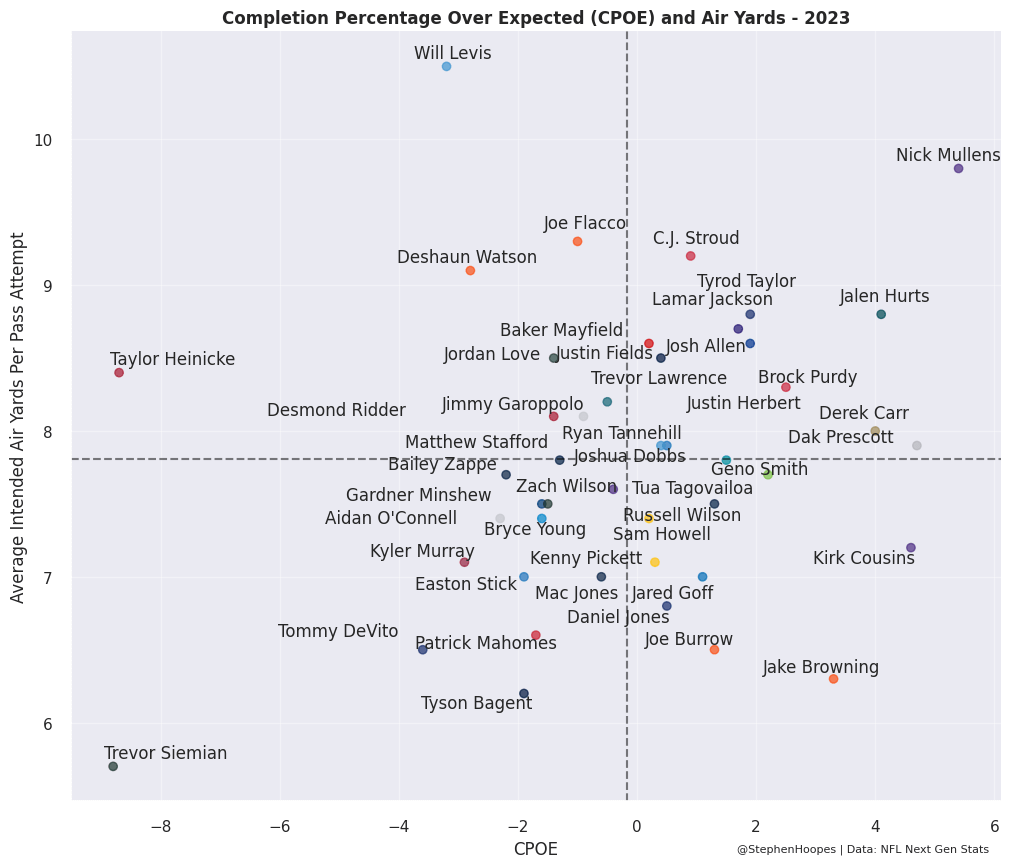
Washington Commanders
And finally, the Washington Commanders were top three in PROE in 2023. That was partially expected with Eric Bieniemy coming over from the Chiefs but also a bit surprising given they didn’t have the QB play to really justify that choice. After bringing in a rookie QB, especially one like Jayden Daniels who has a propensity to turn dropbacks into either sacks or scrambles, we should see a dramatic shift towards the run in 2024.
But we should also see the Commanders play with a lot more pace. They were below-average in situation-neutral pace last season, but their new play caller Kliff Kingsburgy’s teams often lead the league in both pace and no-huddle rate. We’ve seen this in a limited sample during the preseason, as the Commanders have been the fastest team thus far. So, in general, we should see a more run-heavy but faster Commanders team. And Ben Gretch called out an interesting fact from their first pre-season game. In their first drive with the starters, they had four RB touches inside the 10-yard line, which was more than they had in any game last year. That good news for Brian Robinson and Austin Ekeler was stifled by the fact that Daniels finished that drive with a rushing TD of his own.























